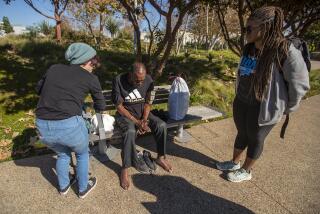Council Rejects Curfew After Anguished Debate : Law enforcement: Police pushed the idea to combat gang activity. Critics said it targeted all youths.
- Share via
SANTA MONICA — Mayor Pro Tem Judy Abdo, declaring that “we should be enforcing behavior, not status,” killed a proposed curfew for minors in Santa Monica, casting the decisive vote against a measure that Police Chief James T. Butts described as an essential tool against gangs.
Nearly two dozen speakers, many of them Santa Monica teen-agers, opposed the plan, which failed Tuesday night on a 3-3 vote.
The curfew would have made it illegal, except under certain circumstances, for minors to be out in public past 11 p.m. on Friday and Saturday and past 10 p.m. on weeknights.
Maya Harris was one of several Santa Monica High School students who spoke against the Police Department proposal. Contending that such a law would be used to target minority youths, she said it was racist, unreasonable, unfair, anti-youth and comparable to a “hate letter.”
“I would suggest that you just say no,” the 11th-grader urged the council.
Ultimately, the council did just that, but only after an anguished debate that forced members to balance their desire to protect the civil liberties of the city’s young people against the threat of opening the door for more gang activity.
Councilmen Herb Katz, Robert T. Holbrook and Kelly Olsen backed the idea of a youth curfew, with Olsen, elected in 1990, saying that it was perhaps his most difficult vote to date.
“This is the first night since I’ve been on this council that I’ve really felt the weight of this job,” Olsen said.
Abdo and Councilmen Dennis Zane and Tony Vazquez opposed the measure. Mayor Ken Genser was absent.
Zane cushioned his opposition to the curfew plan with a glowing endorsement of the chief and a stern reprimand directed at those who attacked the measure as the product of a fascist, totalitarian mentality.
“We are proud of the department . . . and confident of the department’s commitment to fundamental civil liberties,” Zane said.
Nevertheless, Zane termed the proposed curfew a “blunt instrument” in the struggle against gangs and called instead for a more sharply crafted response to the problem.
Santa Monica originally adopted a curfew in 1948, but enforcement was suspended last year after City Atty. Robert M. Myers issued an opinion declaring the law to be unconstitutionally vague.
The law “potentially gives unfettered discretion to police officers who will wind up making moment-to-moment decisions about which children should be investigated, detained and/or arrested,” Myers said.
Police officials said the proposed curfew law, modeled on a Los Angeles ordinance, addressed Myers’ concerns and was consistent with constitutionally unchallenged policies elsewhere.
Without a curfew, police insist that their ability to respond to problems caused by juveniles congregating on the pier, the Third Street Promenade and elsewhere is hindered.
Speaking in support of the measure, Butts cited statistics to dramatize the proliferation of gangs in Los Angeles County, home to 99,000 gang members and 950 documented street gangs as of 1990.
Some of those gang members, he said, have begun to see Santa Monica as a place to hang out, in part because the city does not have a curfew.
Singling out the Promenade as a potential trouble spot, he noted that armed gang members have appeared there showing their colors and engaging in intimidating behavior. Drug selling is also a concern, he said.
The danger is that the Promenade will turn into “another Westwood,” Butts said, referring to a 1988 drive-by shooting that killed an innocent bystander waiting in a movie line and, according to many, caused considerable damage to Westwood’s appeal as an entertainment district.
While stressing his commitment to civil liberties, the chief told the council that a curfew would enable officers to crack down on potential troublemakers.
Law-abiding teens, he stressed, would be left alone.
According to the proposal, any minor accompanied by a parent or guardian or running an errand for a parent or guardian would have been exempt from the curfew.
Also permitted: returning directly home from a movie, play, sporting event or other place of public entertainment, or from a public meeting or school activity or engaging in any legal activity related to a job, business, trade or profession.
But council members and others maintained that the policy would have allowed police to interrogate any youth without establishing probable cause of wrongdoing.
They also questioned the wisdom of punishing all youngsters for the misdeeds of a few.
“I would question what percentage of our kids are involved in this kind of (gang) activity and why all of them should be hauled in by this law,” resident Virginia Clarke told the council.
Immediately after the vote, the council unanimously endorsed a future study session on public safety, a move Butts seemed to find encouraging.
“We may come up with some viable tool for the Police Department yet,” he said as he left the council chambers.
More to Read
Sign up for Essential California
The most important California stories and recommendations in your inbox every morning.
You may occasionally receive promotional content from the Los Angeles Times.













